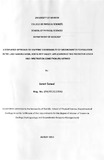| dc.description.abstract | Lake Nakuru Basin is situated along the Kenyan Rift valley, bounded by latitudes 0ᄚ 10' N to 0ᄚ 45' 5 and Longitudes 35ᄚ 90' E to 36ᄚ 20'E and lies at the central part of the rift zone. Water supply in the study area is mainly from groundwater sources, whose quality is influenced by human activities which cause pollution at the land surface since most groundwater originates by recharge of rainwater. The unsaturated zone can help reduce the concentrations of some pollutants entering groundwater (especially micro-organisms), but it can also act as a store for significant quantities of pollutants such as nitrates, which may be released eventually to groundwater.
Some contaminants enter groundwater directly from abandoned wells, and faults which may by-pass the unsaturated zone (overlying layers). Agricultural land use without environmental safeguards to prevent over application of agrochemicals is causing widespread deterioration of the soil/water ecosystem as well as underlying aquifers. Rapid population growth, urbanization and agricultural activities in the basin areas have also put enormous pressure on groundwater resources and catchment areas.
This study aimed at determining the spatial intrinsic variability of groundwater vulnerability to pollution in Lake Nakuru basin applying Protective cover and Infiltration condition (PI) method which is a GIS-based approach. Vulnerability was assessed firstly on the basis of the effectiveness of the protective cover which is a function of soil and lithological properties between the ground surface and the groundwater table, and secondly on infiltration conditions which indicates the degree to which the protective cover is bypassed by surface flow. This assessment took into account core properties such as land cover, slope and locations of fractures that allow surface water to rapidly enter the groundwater aquifer.
Though groundwater table in the study area occurs generally at depths of above 50 m, areas such as Bahati and Dundori are exceptionally characterized by shallow water table occurring at depths less than 2 m to4 m. The resulting vulnerability map indicates low vulnerability of groundwater to pollution in most parts of the study area due to high protection offered by the overlying layers and the depth of most of the groundwater aquifer. This is an exception in areas exhibiting faults where surface water can easily access groundwater if it channels itself through those open faults. In Dundori area, the accessibility of groundwater from shallow wells makes it more vulnerable to pollution due to low protection offered by the thin overlying layers.
From this study, the use of the PI method is demonstrated to be a more successful tool for vulnerability study than other existing techniques applied in the area. Decision makers can use this method as a tool to identify areas contributing to pollution risk in the area. The identified areas can then be prioritized for protection, rather than protecting larger areas which in most cases seem unrealistic due to the ever increasing growth in population. | en_US |

